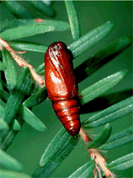We’re under construction - please forgive the mess!
Spruce Budworm
The western spruce budworm is an important native defoliator of interior Douglas-fir in British Columbia. It is not an introduced species. Outbreaks have been recorded in British Columbia since the early 1900's to the present day.
Impacts
Monitoring
Initially, larvae eat the new needles and buds. Older foliage may be attacked if current foliage is depleted. Larvae feed from late April through June. The reddish-brown in affected trees tends to show from June to September.
There can be significant visual impacts from an infestation as trees turn red across mountainsides. In the longer term, trees may have top dieback, growth reduction and, if defoliation occurs for many consecutive years, mortality. Smaller trees are more susceptible as they can become completely defoliated in one season, losing the ability to photosynthesize nutrients.
There can be impacts to forestry as reduced timber value from overall loss of volume in the stand or stem defects from top kill.
If there is widespread mortality, this can lead to danger trees in recreation areas or increased fire hazard.
Next steps
Egg masses are laid in late summer for the following year’s hatch. Egg mass surveys can be done to predict severity in the subsequent year, information useful in planning for possible treatment.
In order for aerial treatment with Btk to be considered, there are a number of criteria that must be in place including approval from First Nations. Currently, the Líl’wat Nation’s Land Use Plan management strategy is to eliminate the use of pesticides and herbicides in the Traditional Territory.
Additional sources:
Every year, as part of an ongoing forest health monitoring program, the Ministry of Forests conducts aerial surveys of forested areas across the province to track visible forest health impacts caused by insects, pathogens, animals and abiotic factors.
This data provides important information on disturbance patterns and helps guide strategic objectives and management plans related to forest health.
Spel’kúmtn Community Forest tenure is located within the Soo Timber Supply area. 2024 data shows an increase in the area affected by the spruce budworm for the third consecutive year. The outbreak initially started in the upper Lillooet and Birkenhead Park area and has been spreading southward. Further details can be found in the summary:
Bacillus thuringiensis var. kurstaki (B.t.k.) is a bacterium that occurs naturally on dead or decaying matter in the soil. It is not a synthetic chemical and is only activated when eaten by a susceptible species of insect. B.t. is the most widely used naturally occurring pest control product in the world. Caterpillars must actively feed upon B.t.k.-treated trees in order to be affected. When B.t.k. is ingested by a susceptible caterpillar, the highly alkaline environment of the caterpillar’s gut triggers the B.t.k. bacterium to release an “endotoxin” (protein) that poisons the insect’s digestive system. The insect may not die immediately after ingesting B.t.k., but generally stops eating and will die within a few days.





